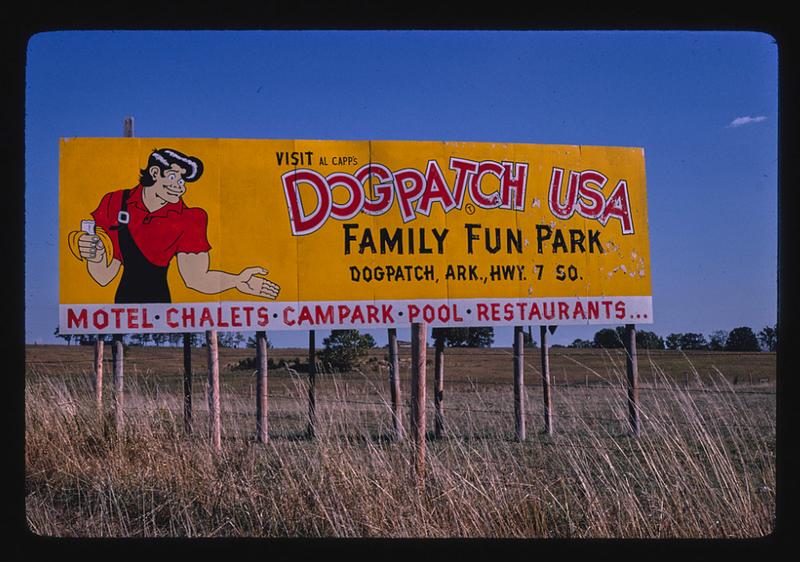The Brief Rise And Fall Of Dogpatch USA
By | January 3, 2022

Starting on August 13, 1934, newspapers across America and Canada began publishing Li’l Abner written and drawn by Al Capp. The comic strip, which ran until November 13, 1977, was about a group of fictional characters in an impoverished Appalachian village, Dogpatch.
When Albert Raney Sr. decided to sell his family’s farm in 1966, the listing agent noted that it would be ideal for a pioneer-themed amusement park. The listing agent, O.J. Snow, thought that the farm resembled features from Li’l Abner, including the “bottomless canyon,” and “Dogpatch Canyon,” where Dogpatch canyon characters brewed Kickapoo Joy Juice. After Snow and his fellow businessmen formed Recreation Enterprises Incorporated (REI), they obtained permission from Al Capp to create the park, which Capp agreed to and became a partner in the project.

Getting The Park Ready To Open
In 1967, they started construction, including the construction of a train from Dogpatch USA to Marble Falls, a tram to bring people from the parking lot to the park entrance, a motel, and a golf course. They renovated Mystic Caverns and renamed it “Dogpatch Caverns,” improving the lighting and remedying the unsafe conditions. They also restored a circa 1834 windmill on the property and reconstructed several authentic 19th-century log cabins in the park. These cabins became the “homes” of the characters from the comic strip, and park visitors could tour them. On May 17, 1968, the park officially opened its gates to about 8,000 visitors. The park’s centerpiece was a statue of the “town hero,” Jubilation T. Cornpone, which Al Capp unveiled at the dedication.

Attractions In The Park
For the initial admission fee of $1.50 for adults and 75 cents for children, visitors could ride a surrey, railroad, or take a trail ride. They could also visit the apiary, tour the grist mill, and visit the petting zoo. If they wanted to, they could fish in the trout pond and the Dogpatch restaurant would cook their catch. At the park, artisans also demonstrated their craft so visitors could see candlemaking, glassblowing, and woodcarving. They could buy local crafts as well, including handmade dulcimers and embroidered aprons. The local products were supplemented by crafts produced elsewhere. Visitors could also stay at Dogpatch USA, as the Dogpatch Inn provided accommodations.

The Park Never Met Expectations
By the end of 1968, they reported a $100,000 net profit which was less than expectations. The consulting firm Economic Research Associates had projected 400,000 visitors in the first year and that within 10 years, attendance would exceed 1 million and the annual revenue would be at $5 million, however, they never exceeded 200,000 annual visitors after the first year. There were plans to expand the park prior to opening for the second season, opening the “Skunk Holler” section, new shops, and Li’l Abner-themed performances. In 1969, they held the first annual Miss Dogpatch pageant, and the B-movie It’s Alive was partly filmed in the park.

They Continued To Try To Improve The Park
By 1972, they had added a motel with 60 mobile-home units, a funicular to bring people to the park entrance, an “Animal World” which included a sea lion exhibit, an aviary, and a children’s water ride. That year, Jess Odom, who had a controlling interest in Dogpatch in 1968, decided to open a sister park, Marble Falls, which was the first ski resort in Arkansas. By the next year, Dogpatch had added a go-cart track, a scrambler, a shooting gallery, a blacklight maze, and a swinging bridge. The next year, a new thrill ride, Hairless Joe’s Kickapoo Barrel, a replica Native American village, and shops for artisans to demonstrate pottery making, leatherworking, and woodworking became part of Dogpatch, USA.

A Perfect Storm Of Events Led To Its Closure
Unfortunately, the park met a series of unfortunate events: attendance dropped, the energy crisis kept people from traveling, the popularity of hillbillies waned, and a mild winter devastated Marble Falls. In 1974, Odom tried to work with the Department of Speech and Dramatic Arts at the University of Arkansas to create a repertory theater in the park which unfortunately was a disappointment. By 1976, Union Planters Bank started to foreclose on Odom’s $3.5 million in debts, and things only got worse when Al Capp retired, bringing an end to Li’l Abner. In 1977, Odom announced the permanent closure of the ski slopes at Marble Falls, although they did advertise new activities there in subsequent years. By 1979, the operating expenses for the park were more than they brought in. However, they continued to add new attractions in 1980, including a trained bear act. With the heatwave of 1980, Dogpatch USA filed for bankruptcy, and Union Planters Bank, which had taken possession of both Dogpatch USA and Marble Falls, put Dogpatch on the market to pay off $7 million in loans. Ozarks Entertainment Inc. (OEI) bought Dogpatch USA in 1981 and began to take the park in new directions, including hosting stars such as Reba McEntire in the amphitheater. That year, Bruce Raney bought Dogpatch Caverns and Old Man Moses Cave and renamed them, renovating Old Man Moses Cave (now called Crystal Dome) and opening both as attractions. Dogpatch continued to face trouble and changed hands as it struggled to survive and faced competition from other parks. In 1991, they even offered free admission to attract visitors; instead, they charged per attraction and kept the arts and crafts aspect. They also dropped the Li’l Abner theme so they no longer paid the Capp estate and changed the name from Dogpatch USA to Dogpatch, Arkansas. Two years later, on October 14, 1993, the park was permanently closed.
